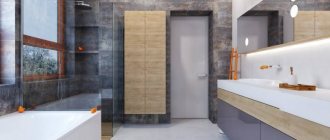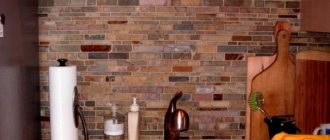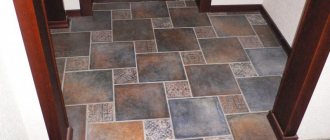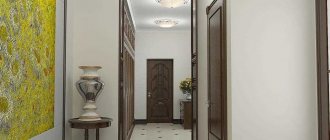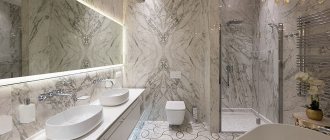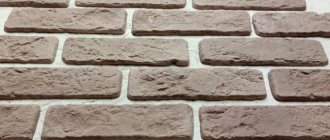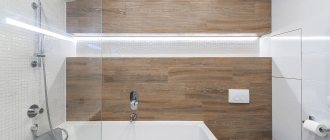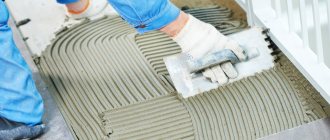Wooden flooring is considered an expensive pleasure, and in rooms with high levels of humidity it is not considered particularly practical, since over time it absorbs moisture, no matter how reliably it is protected. As a result, the owners are trying to find an alternative to such a coating, and in this case, tiles under the laminate will perform well. There are many types of tiles, they differ in design, texture and other features. We invite you to familiarize yourself with all these points in today’s article.
Laying white elongated tiles under laminate Source otdelka1.ru
Advantages of imitating tiles
Fragmented tiles, made in the form of a laminate, practically do not differ in appearance from a real laminated covering; if you also lay a warm floor under it, then the base will serve as a good replacement for standard heating. Floor tiles of this type have a list of the following advantages:
- Elementary care. Such a surface is convenient and safe to clean; simply wipe with a damp cloth, but it is also possible to use special floor cleaning products.
- Environmental friendliness. Tiled facing material is absolutely safe and does not emit any odor during laying or operation. Most models that imitate laminate are often made of ceramic.
- Does not allow moisture to pass through. This property only works if the material is installed correctly. It is important that all seams are carefully sealed, and only then will a good level of waterproofing be ensured.
- Resistant to temperature changes. The tiles withstand heating and cooling well, as a result they do not crack, do not warp, and the protective surface does not wear off. Therefore, a warm floor is often installed under such masonry.
- Long service life. The tile can last for many years even under constant stress testing. The only thing that can affect premature destruction is poor-quality glue that was used to lay the material.
- Easy to install. To glue tiles with an imitated laminate pattern, minimal skills in working with the material and compliance with the level are required. In addition, all pieces of tiles are interchangeable, so if damaged, it is easy to replace it with another fragment, the main thing is that the pattern is respected.
This material also has its own significant disadvantage. The fact is that the surface of the material is quite fragile: falling heavy and sharp objects on it can leave a mark, chip, or crack. Through them, dust and dirt will clog into the inner layers of the tile, which will not look aesthetically pleasing in the future.
Long tiles with laminated pattern Source parket-sale.ru
Video description
An ideal joint between laminate and tile without any consequences.
Aluminum threshold Source mada.kiev.ua
Vinyl threshold
If there are curved joints, it will not be possible to use metal thresholds. In this case, you can purchase flexible vinyl tape that can be laid in any direction. This material is affordable and easy to handle, so craftsmen often find use for it in repairs.
During installation, the first step is to prepare the seam. At the depth of the joint there is a special bridge, the width of which is cut to the tiles and laminate. The profile is fixed to the concrete base with dowels and plugs. Before laying the tape on the profile, it must be treated in a hot liquid to soften it. When the plastic has completely cooled, the vinyl product will be firmly fixed inside the joint.
Choosing tiles for laminate: nuances that are not recommended to be ignored
When planning to make a simulated laminate floor in your home or apartment, you need to analyze several useful qualities. Let's look at them in more detail:
- Compound. In ceramic or any other facing tiles, quartz sand or its analogues are used as a filler. Models with the first bulk material will be many times stronger and stronger, this will increase their service life and resistance to damage. However, this option will be much more expensive than those that use a cheap analogue. Conclusion - purchase the option with quartz sand.
- Form. Tiles with an imitation laminate pattern can have an oblong or square shape. Ideally, give preference to tiles in the form of strips, so the masonry will be as similar as possible to laminated.
- Porosity and roughness. When choosing tiles for the floor in a bathroom, kitchen, hallway, or any other room where the surface may be wet, it is better to avoid smooth, glossy models. Slippery floors will be a common cause of falls.
Model of square tiles with a laminate pattern Source lafaen.ru
Why are combined floors laid?
None of the above floor coverings can be called ideal, since each option has disadvantages. You can solve the problem by installing a combined floor in the kitchen. A combination of finishing materials of different types will also help to divide the space into functional zones.
Pros and cons of combined flooring
Stylish combination of different materials on the kitchen floor
A modern popular trend is the visual division of the kitchen into a dining room and a food preparation area. When approaching the issue of combined floors, you need to pay attention to the combination of floor coverings.
The main advantages of the combination of materials:
- the ability to make the kitchen cozy more economically;
- it’s easy to keep the food preparation area clean, and to create a more aesthetically pleasing and comfortable surface near the dining table;
- proper zoning of the kitchen space;
- practicality and hygiene;
- protection from premature wear of materials in those areas that bear the maximum load.
The disadvantages of this combination include the difficulty in selecting materials from which a harmonious combination can be made, the need for additional processing of joints, and the asymmetry of the room in case of ill-conceived placement of different surfaces.
Types of tiles for the kitchen
Manufacturers offer a huge variety of tiles that can be used as flooring in the kitchen. It comes in a variety of designs and is divided into groups depending on its appearance.
All offered decorative facing tiles can be divided into several types, depending on the material of manufacture:
- ceramic tile;
- glass;
- stone;
- porcelain stoneware
Kitchen tiles come in matte, glossy, sprayed finishes; in an assortment of glass types, you can choose transparent or colored options.
Choosing a laminate
Features of choosing a laminate
Laminate can be used as a floor covering for the kitchen, but subject to the correct choice of type and class, as well as proper preparation of the base. When choosing laminate or porcelain tiles in the kitchen, it is worth considering that the former is pleasant to walk on even barefoot.
Parameters to pay attention to:
- Wear resistance class. The higher it is, the greater the load the coating can withstand.
- Level of moisture resistance (the presence in the description of markings with drops of water, a tap, the words water resistance, waterproof, aqua block, aqua protect).
- Lock connection type. A more reliable and convenient option is the Click dismountable system.
- Manufacturer and guarantees. If your budget is limited, it is better to choose linoleum or tiles.
- Thickness. For a kitchen, hallway or corridor, a coating no thinner than 9 mm is recommended.
- Presence of chamfer. Models without chamfers are more suitable for the kitchen, since dirt and moisture are always retained in the recesses.
- Formaldehyde emission class. Health-safe markings - E0 or E1.
- Anti-slip surface.
Types of tiles for laminate
Imitation of the lamella texture can be done on several types of tile material. In this section, we will consider the existing types and their main characteristics.
Ceramic floor tiles for laminate
This type of tile covering is considered the most popular today. Such material usually has a double pattern, which is coated with fused silicon oxides. The assortment of these may contain a sufficient number of textures and patterns, so there should not be any difficulties when choosing this option.
The material is made by double firing, when the design is applied before and after it. As a result, the finished surface receives the highest quality texture of a laminated base. This is typical for many types of laminate.
Ceramic narrow tiles with an imitated laminate pattern Source rusplitka.ru
Also, tiles with a ceramic base are easier to prepare for work; they are not difficult to trim and correct defects. The material has a good level of thermal insulation. For a bathroom or kitchen, they try to choose lamellar tiles so that the seam is as narrow as possible.
On a note! After firing, air layers appear in a ceramic piece of material that retain heat well.
Porcelain tiles for laminate
This flooring option will cost more than ceramic. It is processed under the influence of high temperatures. This manipulation gives the finished material rigidity and strength. In terms of the quality of resistance to mechanical stress, such tiles have the level of pure granite.
This material is used more in open than in closed spaces. Despite the complexity of the production process, the finished tile very well conveys the texture of natural laminate with all the minor changes in texture. Even by touch it is difficult to distinguish an imitation from the real thing.
Porcelain tiles in the bedroom under a light-colored laminate Source plitkaplus.ru
Pros and cons of tile flooring with imitation laminate
The reason for the popularity of laminate tiles imitating natural laminate is the strength and durability of this floor covering.
After laying the laminate, the lamellas do not fit tightly together or come in waves. Laminate flooring requires some time for each element to “settle” on the substrate.
The protective coating on the surface of natural laminate wears off quite quickly; after just a year, the lamellas lose their shine and brightness.
Modern laminate floor tiles are characterized by increased wear resistance due to the presence of a protective layer of silicon and aluminum. Innovative technologies make it possible to accurately convey the structure and pattern of natural wood.
Ceramic coating is moisture-resistant, unlike laminate or parquet, is not subject to corrosion and is easy to clean from dirt.
The service life of tiles is 30-40 years.
Disadvantages of the material
Ceramic coating has a number of disadvantages:
- high price;
- difficulties in replacing damaged elements;
- high-quality grouting of tile joints is required;
- uncomfortable tactile sensations (cold and hard surface).
Tile design and sizes
There are plenty of design solutions for tiles that would imitate natural laminate as much as possible. In most cases, on the packaging of each batch, the manufacturer indicates the name of the released series and writes in which rooms it is rational to use this option.
The most common is loft. This facing material looks like elongated boards of the same shade of old oak. Often used for living rooms and halls. Another popular option is classic. This is usually produced using walnut or ash pigment. They also try to install such options in living rooms and halls. Floor coverings in large corridors or hallways are also possible.
Interesting two-color tile design for laminate Source parketov-store.ru
Rustic and mosaic designs remain very popular. When the base is decorated in this way, the surface looks like a whole parquet set, which was supposedly assembled from many dies that differ in shade. The pattern of such tiles is often universal, so similar masonry can be used in corridors, kitchens and other rooms where the floor is more likely to get dirty.
The size of the slabs does not have strict standards. Most often it is installed by the manufacturer himself. For example, if these are elongated planks, then usually their aspect ratio is 1:2 or 1:4. There are also options for square-shaped tiles or as close to it as possible.
What to look for when choosing products
Before selecting slabs, it is necessary to determine the color scheme, type of wood pattern, surface texture characteristics, weight, caliber, thickness of finishing blocks.
The weight of 1 m² of porcelain stoneware slab with a thickness of 8 mm is at least 18 kg. Material that weighs less than standard is not reliable enough. For high-quality and durable installation, material of the same caliber is required.
It is important to select the required level of hardness of the composition, because slabs are produced with different wear resistance and degrees of resistance to mechanical damage. The strength parameter is indicated in the marking with PEI symbols and a digital code. A higher value implies a high degree of resistance to damage. PEI V coating is used for pedestrian areas and public buildings. For interior decoration of apartments and cottages, materials marked PEI III are recommended.
The coefficient of friction is indicated by the symbol R and a number. For slabs, the optimal indicator is at least R 11.
Suitable adhesives
Having decided on ceramic or porcelain tiles, you need to take care of choosing an adhesive for laying tiles under the laminate. In this case, it is better to focus on compositions based on latex, cement or acrylic. Other components are also possible. The following compositions will be most suitable.
Adhesive for tiles imitating the design of a laminated floor Source spb.mosplitka.ru
Grouting joints
If the tiles and laminate are located at the same height and the gap between them is minimal, instead of using special layers and thresholds, you can try to rub the joint with a special compound. The butt-to-butt method allows you to implement:
- Sealant. Depending on the size of the gap and the desired effect, you can choose a transparent composition or give preference to a colored material;
- Conventional construction foam;
- Special grouting paste, available in a wide range of colors;
- Fugue for tiles;
- Liquid plug described above.
The characteristics of the listed compositions may differ significantly. When choosing the appropriate option, you should make sure that they have sufficient adhesion to the surface of the tiles and laminate. Otherwise, the desired effect will not be achieved.
How to lay tiles under laminate
Laying tiles under the laminate is accompanied by a preparatory stage, which includes assembling all the tools and the required amount of material. Only then do they begin work according to the following plan:
- Take a package of glue and dilute it in a metal or plastic bucket in the proportions as indicated on the package. Maintain the required consistency.
- The next step is to prepare a notched trowel and scoop some of the solution onto it, apply it to a fragment of the floor to a height of approximately 3-4 mm.
- Now wet the back surface of the tile with primer to improve adhesion.
- Place the end side of the slab on the glue, and then press it evenly on all sides. Check the manipulation with a level; it should show strict horizontality.
Lay all the tiles in the same way, and then insert mounting wedges or crosses between the two fragments and press one tile to the other. This way the seam is made more even and regular.
Important! Install crosses for tiles under laminate in two or three positions (always at the top and bottom of the seam). This will prevent the pieces from moving and creating uneven spaces between the tiles.
Preparation of adhesive composition for laying tiles under laminate Source materik-m.ru
